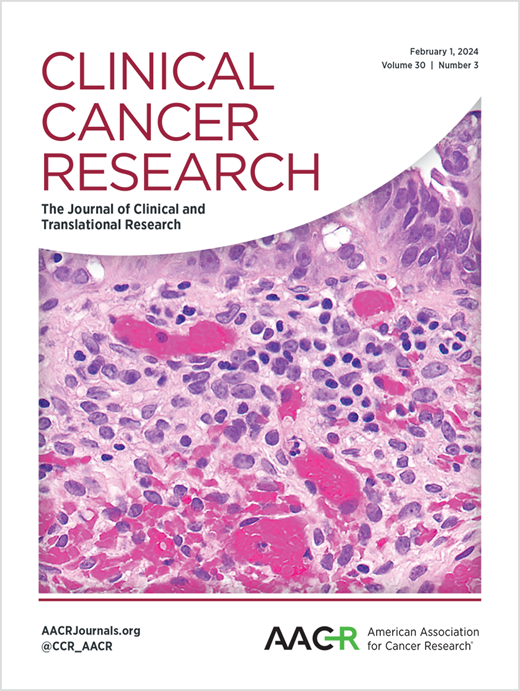E7386 enhances lenvatinib's antitumor activity in preclinical models and human hepatocellular carcinoma.
IF 10.2
1区 医学
Q1 ONCOLOGY
引用次数: 0
Abstract
PURPOSE Aberrant activation of β-catenin (CTNNB1) occurs in ~30% of hepatocellular carcinomas (HCC) and is associated with immune evasion and limited response to immunotherapy. However, it remains an undruggable target. Here, we studied the antitumor and antiangiogenic activity of combining E7386 (an oral protein-protein interaction inhibitor targeting CREB-binding protein (CBP)/β-catenin) with lenvatinib and elucidated a novel mechanism of action of E7386 that boosts antitumor response. EXPERIMENTAL DESIGN We generated a genetically engineered CTNNB1-mutant murine HCC model and randomized the animals to receive vehicle, E7386, lenvatinib, or the combination (n=22-23/arm). We evaluated survival and analyzed the tumors transcriptomically and by immunohistochemistry. Also, we analyzed five patient-derived organoids (PDOs), four HCC cell lines, and seven paired pre-/on- treatment specimens from HCC patients receiving E7386 in combination with lenvatinib in the context of a phase 1b/2 trial (NCT04008797). RESULTS E7386 in combination with lenvatinib significantly prolonged mouse survival versus monotherapy. Cell lines and PDO data corroborated that sensitivity to E7386 involves processes beyond CBP/β-catenin interaction blockade. Mechanistically, E7386 promoted Activating Transcription Factor 4 (ATF4) activation, triggering integrated stress response in preclinical models of HCC. In vivo, E7386 concomitantly potentiated the antiangiogenic effects of lenvatinib, resulting in increased antitumor efficacy. Upregulation of ATF4 gene expression signatures was confirmed in four out of seven E7386+lenvatinib-treated HCC patients, three of which exhibited tumor diameter shrinkage >30%. CONCLUSIONS E7386 sensitized tumors to lenvatinib, thereby enhancing survival in mice compared with either monotherapy. In patients, E7386 combined with lenvatinib promoted tumor shrinkage and, in parallel, activated ATF4 signaling.E7386增强lenvatinib在临床前模型和人肝细胞癌中的抗肿瘤活性。
目的:β-连环蛋白(CTNNB1)的异常激活发生在约30%的肝细胞癌(HCC)中,并与免疫逃避和对免疫治疗的有限反应有关。然而,它仍然是一个不可战胜的目标。本研究研究了E7386(一种靶向creb结合蛋白(CBP)/β-catenin的口服蛋白-蛋白相互作用抑制剂)与lenvatinib联合的抗肿瘤和抗血管生成活性,并阐明了E7386增强抗肿瘤反应的新作用机制。实验设计:我们建立了一种基因工程ctnnb1突变小鼠HCC模型,并将动物随机分配接受载体、E7386、lenvatinib或联合用药(n=22-23/组)。我们通过转录组学和免疫组织化学对肿瘤进行存活和分析。此外,在1b/2期临床试验(NCT04008797)中,我们分析了5个患者源性类器官(PDOs)、4个HCC细胞系和7对接受E7386联合lenvatinib治疗的HCC患者治疗前/治疗后标本(NCT04008797)。结果与单药治疗相比,tse7386联合lenvatinib可显著延长小鼠生存期。细胞系和PDO数据证实了对E7386的敏感性涉及CBP/β-catenin相互作用阻断之外的过程。在机制上,E7386促进激活转录因子4 (ATF4)的激活,在临床前HCC模型中触发综合应激反应。在体内,E7386同时增强lenvatinib的抗血管生成作用,从而增加抗肿瘤疗效。在7例E7386+lenvatinib治疗的HCC患者中,有4例证实ATF4基因表达特征上调,其中3例肿瘤直径缩小bbb30 %。结论:与单药治疗相比,se7386使肿瘤对lenvatinib增敏,从而提高小鼠的生存率。在患者中,E7386联合lenvatinib促进肿瘤缩小,同时激活ATF4信号。
本文章由计算机程序翻译,如有差异,请以英文原文为准。
求助全文
约1分钟内获得全文
求助全文
来源期刊

Clinical Cancer Research
医学-肿瘤学
CiteScore
20.10
自引率
1.70%
发文量
1207
审稿时长
2.1 months
期刊介绍:
Clinical Cancer Research is a journal focusing on groundbreaking research in cancer, specifically in the areas where the laboratory and the clinic intersect. Our primary interest lies in clinical trials that investigate novel treatments, accompanied by research on pharmacology, molecular alterations, and biomarkers that can predict response or resistance to these treatments. Furthermore, we prioritize laboratory and animal studies that explore new drugs and targeted agents with the potential to advance to clinical trials. We also encourage research on targetable mechanisms of cancer development, progression, and metastasis.
 求助内容:
求助内容: 应助结果提醒方式:
应助结果提醒方式:


